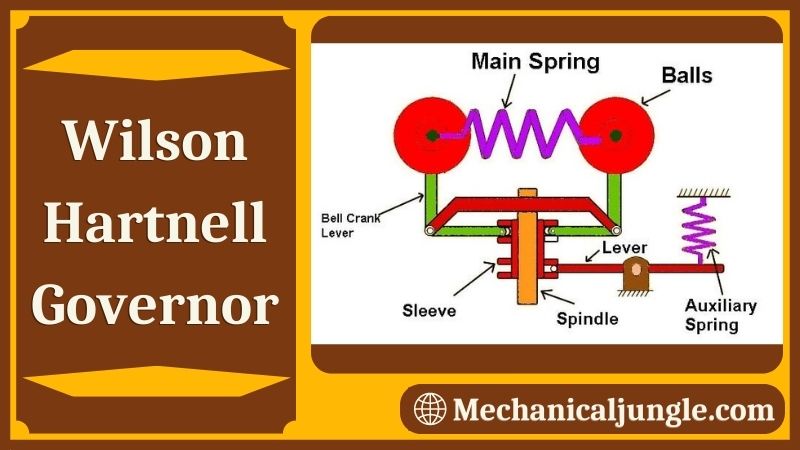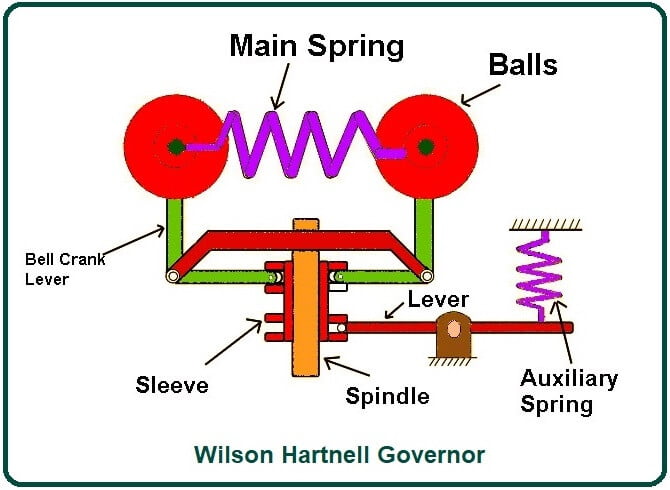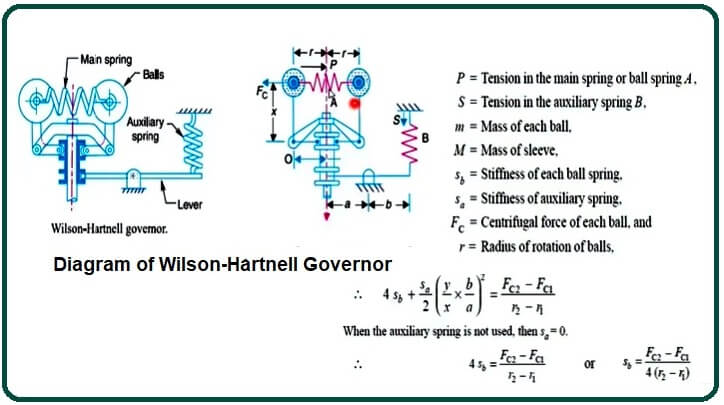Important Point
What Is Wilson-Hartnell Governor?
The Wilson-Hartnell governor is a spring-controlled load governor classified under centrifugal governors. We have discussed Hartung governor and Hartnell governor in previous articles, which are also spring-loaded governors with different constructions and working principles of this type of governor.
Wilson Hartnell Governor:
It is also known as a spring-loaded governor. It is a special type of governor in which a spring is attached between the balls of the governor. This spring is called Main Spring.
The mainspring is stretched and placed between the balls, which means that the mainspring always exerts an inward force to both fly balls. It also has another spring which is known as an auxiliary spring. It is connected to the auxiliary spring sleeve via a pivoted lever.
Also, Read: Difference Between Orthogonal and Oblique Cutting | Orthogonal Machining
Construction of Wilson Hartnell Governor:
In Wilson Hartnell Governor, fly balls are connected to each other through spring. This spring is called the main wire and is placed between the balls in a stretched position and forces both balls inward. Apart from this spring, thises governor also has an assistant spring.
These auxiliary springs are connected to the sleeve through a lever. When the sleeve moves up, the other part of the lever moves down, and the supporting spring is pulled, and the other part of the lever is pulled upward, and the sleeve is upward. This auxiliary spring helps maintain the balance speed of the governor.
These two balls are attached to the rollers through the bell crank lever. This bell crank lever is also known as a ring. The rollers are attached to the sleeves. Two fly balls and spindles are attached to the engine shaft that rotates the spindle.
Also, Read: Construction of Dog Clutch | Working of Dog Clutch | Advantages of Dog Clutch | Disadvantages of Dog Clutch
Working of Wilson Hartnell Governor:
When the spindle rotates, the bell cranks lever rotates with the spindle, and the fly ball attached to the crank lever rotates as well; the centrifugal force is experienced by the two balls that pull the ball away from each other but in the mainspring balls.
Pulls one towards the other. When the rotation speed of the spindle increases, the radius of rotation of the balls increases. Due to the external movement of the balls, the bell crank lever lifts up and so lifts the sleeve. So when the sleeves go up, the fuel supply decreases.
When the rotation speed of the spindle decreases, the radius of rotation of the balls decreases, and the balls get closer to each other. Due to the arrival of the balls, the bell crank lever moves down, and hence the sleeve goes down. The fuel supply increases when the sleeve goes down.
The bell crank lever rotates along the spindle. When the speed increases the rotation radius of the ball increases. The ball’s outward motion activates the bell crank lever and lifts the governor sleeve—the upward movement of the sleeve in the fuel supply decreases, and therefore, the engine speed decreases.
Likewise, when the spindle speed decreases, the ball moves inward. This is the result of the fall of the governor sleeve and the increase in fuel supply.
Also, Read: What Is a Flame in Gas Welding? | Types of Flames in Gas Welding
Diagram of Wilson-Hartnell Governor:
Frequently Asked Questions (FAQ)
Wilson Hartnell Governor
Wilson Hartnell Governor is a spring-loaded type of governor in which balls are connected by springs in tension. Here, two bell crank levers are pivoted at the ends of vertical and horizontal arms. The fly-balls are attached to the ends of the vertical arms of bell crank levers.
Like this post? Share it with your friends!
Suggested Read –
- What Is Centrifugal Casting
- Working Principles of Centrifugal Pump
- What Is a Flame in Gas Welding? | Types of Flames in Gas Welding
- What Is Pirani Gauge? | Working of Pirani Gauge | Construction of Pirani Gauge | Principle of Pirani Gauge
- Parts of Air Lift Pump | Working Principle of Air Lift Pump | Advantages of Air Lift Pump | Disadvantages of Air Lift Pump
- Pattern Allowances In Casting | Why the Pattern Allowances In Casting Affected | Finishing or Machining Allowance | Shake or Rapping Allowance
- Difference Between Air Conditioning and Refrigeration Why We Need a Refrigeration | Refrigeration System | Refrigeration Cycle | Principle of Refrigeration


